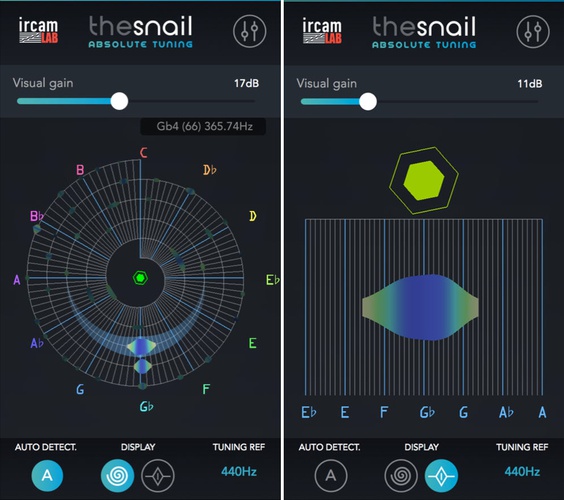Le Snail disponible sur iOS
Technologie brevetée par le CNRS(1), ce logiciel, et maintenant application, offre de nouvelles façons d'accorder un instrument de musique, de travailler l'intonation, de visualiser la musique et les sons en temps réel depuis un mobile ou une tablette sous iOS. Conçu par le laboratoire Sciences et technologies de la musique et du son (CNRS/Ircam/ministère de la Culture et de la Communication/UPMC), ce logiciel est une technologie innovante pour les musiciens et tous ceux qui travaillent le son, adaptée aux amateurs comme aux professionnels.
Un son est une vibration acoustique de l'air. Cette vibration, ou signal, se compose d'oscillations d'amplitudes et fréquences différentes, dont l'ensemble forme le « spectre du son ». Les analyseurs de spectres sonores standards affichent des courbes d'amplitude, correspondant au volume du son, en fonction de la fréquence, c'est-à-dire le nombre de vibrations par seconde. Ces courbes résultent d'une transformation du signal pour un analyseur standard.

À partir de ce principe, les scientifiques ont développé ce nouvel algorithme destiné à analyser l'ensemble des composantes spectrales du son et permettant de représenter ces informations sous une forme visuelle. Avec le mode « Snail » tout d'abord, les zones actives du contenu spectral sont représentées par des taches lumineuses sur un squelette en spirale : un tour correspond à une octave, les notes graves se trouvent près du centre de la spirale et les notes plus aiguës en sont éloignées, la fréquence du diapason (440 Hz par défaut)(2) est symbolisée par un point épais sur le squelette. Pour chaque fréquence analysée, l'amplitude est convertie en sonie (une valeur numérique qui représente le volume sonore tel que perçu par l'être humain)(3), elle-même convertie en niveau de brillance : si une composante est deux fois plus forte, la tache est deux fois plus brillante. La taille de la tache augmente en fonction de la sonie et de la qualité de la synchronisation avec la phase démodulée. L'utilisateur peut ainsi ajuster la finesse de la localisation de la tache en fonction de l'opération visée (accordage, visualisation de la musique, etc.). Des informations complémentaires sont indiquées par des couleurs, selon plusieurs modes choisis (volume sonore, phase démodulée, etc.). Deux modes supplémentaires sont également prévus. Le mode « spectrogramme » qui permet d'afficher les zones sonores actives sur un clavier avec un défilement temporel et le mode « accordeur » qui propose un zoom autour de la composante d'une note cible sélectionnée. De plus, pour cette note cible, un motif est représenté avec l'angle donné par la phase démodulée : sa rotation permet une estimation fine de la qualité de l'accordage (un tour réalisé en 2 secondes signifie que le défaut de l'accord est de 0.5 Hz).
Le Snail permet donc d'améliorer la précision d’analyse, à un taux ajustable, selon que l'on souhaite un mode accordage ou visualisation de la musique par exemple. Ce logiciel permet notamment d'extraire des composantes stables noyées dans un environnement perturbé (bruit, voix parlée, etc.) et facilite les opérations d'accordage, y compris pour des sons faiblement ou fortement inharmoniques (une « mauvaise » corde pouvant être immédiatement identifiée) sans dégrader la précision. Le Snail: Absolute Tuning apporte donc de nouvelles solutions pour visualiser le spectre des sons avec une représentation adaptée à la perception, pour accorder un instrument avec une grande précision et sonder simultanément la qualité harmonique de la note accordée. C'est une nouvelle façon pour les musiciens de redécouvrir et de se réapproprier de façon interactive le monde des sons et des vibrations.
1. Brevet déposé le 07/05/2014 sous le numéro FR 1455456 au nom du CNRS pour lequel l'Ircam a les droits d'exploitation dans le domaine de l'acoustique musicale.
2. Le hertz (symbole : Hz) est l’unité de fréquence du système international (SI). Un hertz est équivalent à un événement par seconde (s-1 ou 1/s).
3. Correspondant ici au standard ISO226:2003.
Disponible sur Mac, PC, standalone et plugin sous Plugivery et sur iOS



